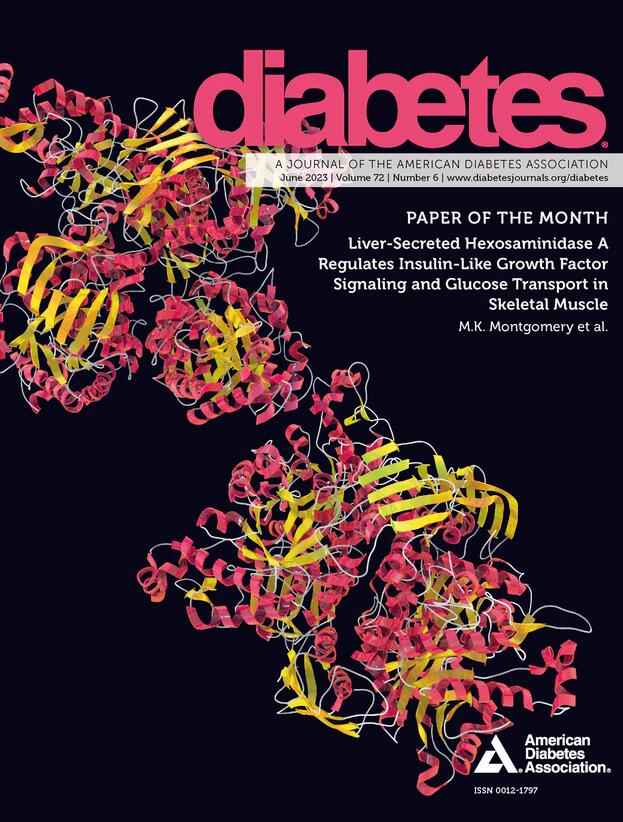G protein-coupled receptor 35 suppresses oxidative stress response 1 in diabetic wound healing
IF 6.2
1区 医学
Q1 ENDOCRINOLOGY & METABOLISM
引用次数: 0
Abstract
G protein-coupled receptor 35 (GPR35) is a poorly characterized receptor with unclear intracellular mechanisms in endothelial cells (ECs). Oxidative stress responsive 1 (OXSR1) is a serine/ threonine protein kinase that modulates cell morphology and has recently been found to promote angiogenesis. We hypothesized that GPR35 inhibition promotes EC angiogenesis via augmenting OXSR1 activity and accelerating wound healing in diabetes. Here, we show that active GPR35 contributed to the impaired migration and tube formation of human dermal microvascular endothelial cells (ECs) from type 2 diabetic (T2D) patients or ECs exposed to high glucose. Proximity labeling and coimmunoprecipitation identified OXSR1 as an interacting partner of GPR35 in ECs. GPR35 suppressed OXSR1 from translocating to nuclei to activate SMAD1/5, thereby inhibiting the transcription of angiogenic factors. Furthermore, enhanced wound angiogenic response and accelerated wound closures were observed in induced T2D mice with topical application of GPR35 siRNA, or in T2D models of transgenic mice with either global or endothelial-selective GPR35 deletion. Our data suggest that GPR35 suppresses OXSR1-dependent angiogenic activity in ECs, contributing to poor angiogenesis and delayed wound healing in T2D animals. This study provides both in vitro and in vivo evidence for GPR35 as a potential therapeutic target in tissue repair in patients with diabetes.G蛋白偶联受体35抑制糖尿病伤口愈合中的氧化应激反应1
G蛋白偶联受体35 (GPR35)在内皮细胞(ECs)中是一种特征不明确的细胞内机制受体。氧化应激反应1 (OXSR1)是一种丝氨酸/苏氨酸蛋白激酶,可调节细胞形态,最近发现可促进血管生成。我们假设GPR35抑制通过增强OXSR1活性和加速糖尿病伤口愈合来促进EC血管生成。在这里,我们发现活性GPR35有助于2型糖尿病(T2D)患者或暴露于高糖环境的人皮肤微血管内皮细胞(ECs)的迁移和管形成受损。接近标记和共免疫沉淀鉴定OXSR1是ECs中GPR35的相互作用伙伴。GPR35抑制OXSR1转位到细胞核激活SMAD1/5,从而抑制血管生成因子的转录。此外,在局部应用GPR35 siRNA诱导的T2D小鼠中,或在GPR35全缺失或内皮选择性缺失的转基因小鼠的T2D模型中,观察到伤口血管生成反应增强和伤口闭合加速。我们的数据表明,GPR35抑制ECs中oxsr1依赖性血管生成活性,导致T2D动物血管生成不良和伤口愈合延迟。本研究为GPR35作为糖尿病患者组织修复的潜在治疗靶点提供了体外和体内证据。
本文章由计算机程序翻译,如有差异,请以英文原文为准。
求助全文
约1分钟内获得全文
求助全文
来源期刊

Diabetes
医学-内分泌学与代谢
CiteScore
12.50
自引率
2.60%
发文量
1968
审稿时长
1 months
期刊介绍:
Diabetes is a scientific journal that publishes original research exploring the physiological and pathophysiological aspects of diabetes mellitus. We encourage submissions of manuscripts pertaining to laboratory, animal, or human research, covering a wide range of topics. Our primary focus is on investigative reports investigating various aspects such as the development and progression of diabetes, along with its associated complications. We also welcome studies delving into normal and pathological pancreatic islet function and intermediary metabolism, as well as exploring the mechanisms of drug and hormone action from a pharmacological perspective. Additionally, we encourage submissions that delve into the biochemical and molecular aspects of both normal and abnormal biological processes.
However, it is important to note that we do not publish studies relating to diabetes education or the application of accepted therapeutic and diagnostic approaches to patients with diabetes mellitus. Our aim is to provide a platform for research that contributes to advancing our understanding of the underlying mechanisms and processes of diabetes.
 求助内容:
求助内容: 应助结果提醒方式:
应助结果提醒方式:


